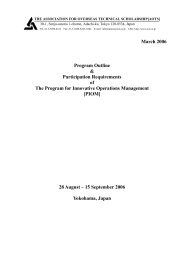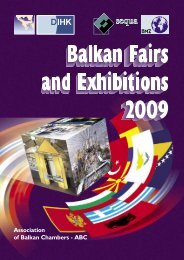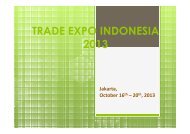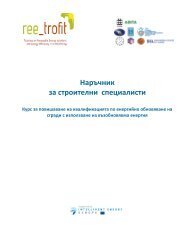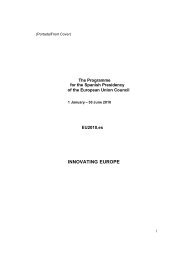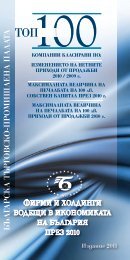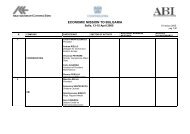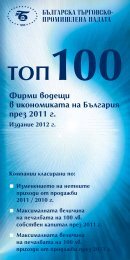Analysis of the Operation and Financial Condition of the Enterprise
Analysis of the Operation and Financial Condition of the Enterprise
Analysis of the Operation and Financial Condition of the Enterprise
You also want an ePaper? Increase the reach of your titles
YUMPU automatically turns print PDFs into web optimized ePapers that Google loves.
<strong>Analysis</strong> <strong>of</strong> <strong>the</strong> <strong>Operation</strong> <strong>and</strong> <strong>Financial</strong> <strong>Condition</strong> <strong>of</strong> <strong>the</strong> <strong>Enterprise</strong>investments are done for <strong>the</strong> period <strong>of</strong> time only when <strong>the</strong> cash assets are not needed for <strong>the</strong>current needs <strong>of</strong> an enterprise.Accounts receivable are <strong>the</strong> unpaid invoices issued by an enterprise for <strong>the</strong> goodssold (services provided). Accounts receivable are short-term debts with <strong>the</strong> repaymentperiod less than a year. These debts arise upon selling goods to customers on credit (ondebt) with a certain period <strong>of</strong> payment, for example, 1-3 months upon delivery <strong>of</strong> goods.Accounts receivable are shown on <strong>the</strong> balance sheet according to actual sales value<strong>of</strong> <strong>the</strong> goods, i.e., based on <strong>the</strong>ir amount <strong>of</strong> cash. In <strong>the</strong> annual report <strong>the</strong> net accountsreceivable amount is disclosed as <strong>the</strong> difference between <strong>the</strong> actual amount <strong>of</strong> accountspayable <strong>and</strong> any provisions for doubtful debts disclosed on <strong>the</strong> liabilities side <strong>of</strong> <strong>the</strong>balance sheet.Production reserves are tangible assets intended for sale in <strong>the</strong> course <strong>of</strong> a regulartrading cycle or for use in <strong>the</strong> process <strong>of</strong> goods production <strong>and</strong> fur<strong>the</strong>r sales <strong>of</strong> <strong>the</strong>se goods.These items are usually called <strong>the</strong> materials <strong>of</strong> goods <strong>and</strong> are composed <strong>of</strong> raw materials,packing materials, semi-finished goods <strong>and</strong> components usually purchased from <strong>the</strong>suppliers.Production reserves are a less liquid group <strong>of</strong> <strong>the</strong> current assets however it is veryimportant to include <strong>the</strong>m in <strong>the</strong> analysis. Inventories may constitute a significantpercentage not only from <strong>the</strong> current, but also from <strong>the</strong> total enterprise assets. This couldbe an evidence <strong>of</strong> difficulties that <strong>the</strong> enterprise is facing regarding <strong>the</strong> sales <strong>of</strong> goods,which has been caused, on its turn, by insufficient market research <strong>and</strong> quality <strong>of</strong> products.Deviations <strong>of</strong> <strong>the</strong> amount <strong>of</strong> inventories from <strong>the</strong> optimum level may incur losses in<strong>the</strong> enterprise activities as <strong>the</strong> inventory storage costs are rising, liquid assets are taken out<strong>of</strong> circulation, <strong>the</strong> threat <strong>of</strong> impairment <strong>of</strong> <strong>the</strong> stock value is occurring.Fixed assets are assets acquired for continuing use by <strong>the</strong> enterprise including l<strong>and</strong>,buildings, constructions, plant <strong>and</strong> machinery, equipment <strong>and</strong> transport vehicles. In <strong>the</strong>course <strong>of</strong> operation <strong>the</strong>se assets (excluding l<strong>and</strong>) wear out causing <strong>the</strong> need to graduallywrite <strong>of</strong>f <strong>the</strong>ir value or amortise <strong>the</strong>m. Due to <strong>the</strong> above fixed assets in <strong>the</strong> balance sheetare reflected at to <strong>the</strong>ir net book value, i.e., <strong>the</strong> original value is reduced by an amount <strong>of</strong>depreciation.Fixed assets are a group <strong>of</strong> assets: for which depreciation is calculated; that are intended for use in <strong>the</strong> enterprise for a period <strong>of</strong> above one year; that have a limited period <strong>of</strong> service; that are used by an enterprise for production <strong>and</strong> sales <strong>of</strong> goods <strong>and</strong> provision<strong>of</strong> services or for lease.Depreciation is <strong>the</strong> distribution <strong>of</strong> <strong>the</strong> depreciable value <strong>of</strong> a fixed asset over <strong>the</strong> preestimatedterm <strong>of</strong> <strong>the</strong> transaction (for example, 2, 5 or 10 years). Depreciation calculated fora reporting period reduces <strong>the</strong> pr<strong>of</strong>it for <strong>the</strong> year reported.Long-term financial investments are amounts <strong>of</strong> spare cash given at <strong>the</strong> disposal <strong>of</strong>o<strong>the</strong>r enterprises for more than one year with a view <strong>of</strong> earning regular income in <strong>the</strong> form<strong>of</strong> interest on loans or credit facilities, or else in <strong>the</strong> form <strong>of</strong> dividends from investments in<strong>the</strong> shares <strong>of</strong> o<strong>the</strong>r enterprises. Along with short-term financial investments this itemreflects <strong>the</strong> enterprise performance in <strong>the</strong> financial markets.51



